
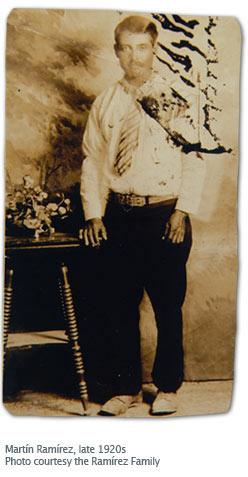
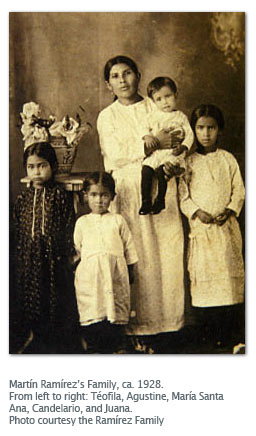
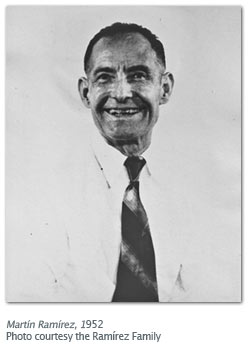
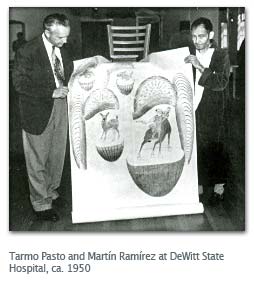
BioThis project unveils new research about Martín Ramírez’s life and family and corrects some of the information that has been published over the course of the past five decades. Up until now, we did not have accurate life dates for the artist, for example. His family remained unknown to the art world, and most admirers of Ramírez’s drawings wrongly assumed there was no family. We did not know where in Mexico he was from, and much of the information about his life in the United States was incorrect. It has long been assumed that Ramírez was mute, but recent research shows that to be untrue. He was first described by Tarmo Pasto as “choosing not to speak, only hum.” Later accounts evolved from “he was mute” to “he could not speak” to, eventually, “he never spoke.” This reevaluation of prior biographical assessments invites a reexamination of the artist’s entire history, including his diagnosis as a paranoid schizophrenic. Interestingly, after Ramírez died, even Dr. Pasto questioned his diagnosis and suggested that the artist was not mentally ill. The following time line was compiled by Víctor M. Espinosa and Kristin E. Espinosa, and reflects the years of research they conducted to provide an accurate record of the life of Martín Ramírez. 1895Martín Ramírez González is born on January 30 in Rincón de Velázquez, Tepatitlán, Jalisco, Mexico. On January 31, he is baptized in San Francisco de Asís, the central parish of Tepatitlán.1918On May 31, Ramírez marries 17-year-old María Santa Ana Navarro Velázquez in the small parish of Capilla de Milpillas, Tepatitlán. The Ramírez family moves to Tototlán, Jalisco.1919On March 8, the Ramírezes’ first daughter, Juana, is born in El Venado, Tototlán.1921On January 8, the Ramírezes’ second daughter, Teófila, is born in La Puerta del Rincón, Tototlán. On May 20, Ramírez’s older brother Atanacio marries Dominga Navarro, the younger sister of María Santa Ana.1923On August 28, the Ramírezes’ third daughter, Agustina, is born in El Pelón, Tototlán. Ramírez buys a small piece of land on credit, in a ranchería near San José de Gracia, Tepatitlán.1925On August 24, Ramírez leaves for the United States.1925–1930Ramírez works on the railroad and in the mines of northern California.1926On February 2, the Ramírezes’ only son, Candelario, is born in San José de Gracia.Late 1920sRamírez makes his first drawings in the margins of letters to his family.1931On January 9, Ramírez is picked up by the San Joaquin County, California, police and committed to Stockton State Hospital, where he receives a preliminary diagnosis of manic depression.1932In April, Ramírez makes his first escape from the hospital. 1933 In July, Ramírez escapes Stockton for the second time. After a few days in jail, he is committed to the hospital again. On August 12, he is diagnosed with dementia praecox, catatonic form.1934Ramírez escapes Stockton again but returns of his own volition after spending three or four days on the streets.Mid-1930sRamírez begins to draw on a more regular basis. The Ramírez family receives a letter from Stockton State Hospital, informing them about Ramírez’s condition.1944The newly built DeWitt State Hospital in Auburn, California, is opened to receive wounded World War II soldiers.1946The War Assets Administration sells DeWitt to the California government. It starts receiving transfers of senile, aged, mentally ill, and tubercular patients from overcrowded California state hospitals.1948Some of Ramírez’s drawings are sent by Stockton State Hospital to his family in Mexico. Ramírez is transferred to DeWitt. Tarmo Pasto, who has just become professor of psychology and art at Sacramento State College, meets Ramírez.1951Ramírez’s first solo show is organized at the E.B. Crocker Art Gallery in Sacramento.1952On January 6, Ramírez receives his first and only visit from a family member when his nephew José Gómez Ramírez arrives for two days. Tarmo Pasto receives a grant from the Ford Foundation Fund for the Advancement of Education for yearlong research into “psychology theory and art expression.” In November, a solo Ramírez exhibition is organized by Pasto at the Women’s clubrooms of Stephens Union at the University of California, Berkeley.Early 1950sThe first solo Ramírez exhibition on the East Coast, organized by Pasto, takes place at the Joe and Emily Lowe Art Center at New York’s Syracuse University. In January, the solo Ramírez show “The Art of a Schizophrene” opens at the Mills College Museum of Art in Oakland. In May, Pasto organizes an exhibition of artwork by patients from various California mental hospitals, including Martín Ramírez, at the M.H. de Young Memorial Museum in San Francisco.1955Pasto sends ten of Ramírez’s drawings to James Johnson Sweeney, director of the Solomon R. Guggenheim Museum in New York, but no plans are made for an exhibition.1956Pasto goes to Helsinki on a Fulbright fellowship. His visits to Ramírez become less frequent.ca. 1959Pasto visits Ramírez for the last time.1963On February 17, Ramírez dies at DeWitt of a pulmonary edema. ® American Folk Art Museum |
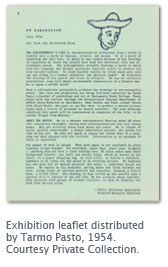
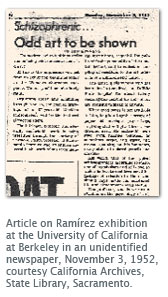
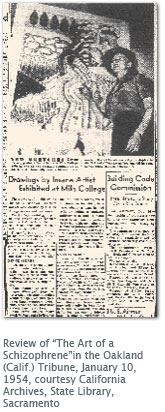
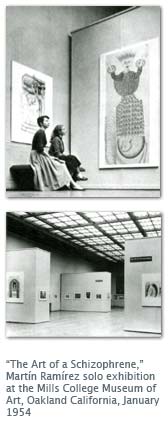
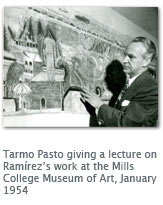
© Copyright 2007 Milwaukee Art Museum